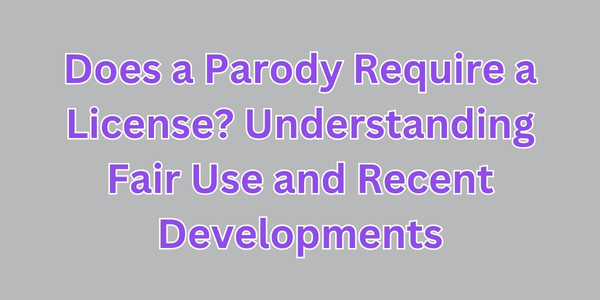Parody has long been a powerful tool in art, comedy, and commentary. But when it comes to using copyrighted material, creators often ask: Do I need permission or a license to create a parody?
The short answer in the United States: Not usually. Parody is often protected by the fair use doctrine, and recent developments in case law have clarified—but not overturned—these protections.
The Fair Use Foundation
Under U.S. copyright law, parody is generally considered transformative use, which means it adds new meaning or message to the original work. This is a critical factor in determining whether a use qualifies as fair use under Section 107 of the Copyright Act.
Read more from the U.S. Copyright Office
The Landmark Case: Campbell v. Acuff-Rose (1994)
The U.S. Supreme Court’s ruling in Campbell v. Acuff-Rose Music, Inc. centered around 2 Live Crew’s parody of Roy Orbison’s “Oh, Pretty Woman.” The Court ruled that:
A commercial parody may be fair use if it is transformative and doesn’t harm the market value of the original.
The Court emphasized that parody must use elements of the original work to “conjure it up,” especially if the parody is clearly commenting on the original.
The Four-Factor Fair Use Test for Parody
Fair use is assessed on a case-by-case basis using these four factors:
- Purpose and Character of the Use
- Parody is typically transformative and protected even when commercial.
- Nature of the Original Work
- Creative works get stronger protection, but that doesn’t override parody.
- Amount and Substantiality of the Portion Used
- Only what’s necessary to “call to mind” the original is permitted.
- Effect on the Market
- Parodies usually don’t replace the original in the marketplace.
Recent Developments in the Law
Andy Warhol Foundation v. Goldsmith (2023)
In this case, the Supreme Court ruled that stylistic transformations alone do not make a work “transformative” under fair use if the new work has the same commercial purpose. While this case didn’t involve parody directly, it emphasized the importance of purpose and meaning in fair use claims.
Lower courts have echoed this reasoning in recent parody decisions, noting that parodies which directly critique or mock the original work remain clearly within the boundaries of fair use. If a “parody” merely borrows the aesthetic or structure of the original without commenting on it, fair use may not apply.
🎤 Real-World Examples of Legal Parody
1. 2 Live Crew – “Pretty Woman”
- Parodied: Roy Orbison’s “Oh, Pretty Woman”
- Ruling: Campbell v. Acuff-Rose (1994)
- Why it matters: Confirmed that parody—even commercial—can be fair use.
- 📖 Case Summary
2. The Onion
- Parodied: News, politics, and social issues
- Why it matters: The Onion’s work is satire, which overlaps with parody in fair use protection. Their content is widely recognized as transformative commentary.
3. South Park – “Canada on Strike”
- Parodied: Viral content like “Chocolate Rain”
- Why it matters: The show mocked internet celebrity culture while mimicking original works for comedic commentary.
4. Saturday Night Live (SNL)
- Parodied: Public figures, media, brand names
- Why it matters: SNL regularly produces content that qualifies as parody, offering critique and social commentary on recognizable subjects without needing licenses.
5. “Weird Al” Yankovic
- Parodied: Dozens of pop hits (“Eat It,” “Like a Surgeon”)
- Why it matters: Weird Al voluntarily seeks permission, but it’s not legally required. He does it as a courtesy—not because the law demands it.
Practical Tips for Parody Creators
- Make sure your work directly targets or comments on the original.
- Use only what’s necessary to evoke the original.
- Be mindful of the market impact—don’t create a substitute for the original.
- When in doubt, consult an intellectual property attorney, especially for commercial releases.
Final Thoughts
Parody remains strongly protected under U.S. copyright law, and there have been no new statutes requiring licensesfor parody works as of 2025. However, court decisions like Warhol v. Goldsmith are shaping how transformation is understood, so creators should remain thoughtful and deliberate.
Legal Disclaimer
This blog post is for informational purposes only and does not constitute legal advice. The fair use doctrine is interpreted on a case-by-case basis. If you are creating a parody or derivative work involving copyrighted material, consult a qualified intellectual property attorney.
Further Reading
- U.S. Copyright Office: Fair Use
- Campbell v. Acuff-Rose Case Summary
- Warhol v. Goldsmith Law Review Analysis
